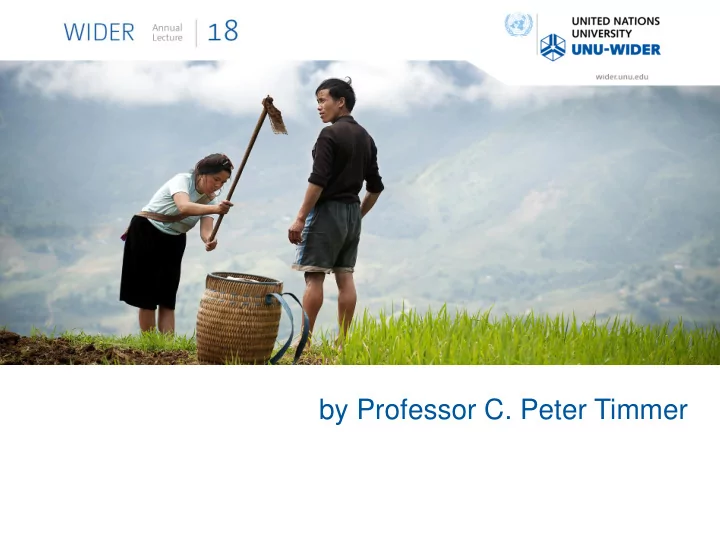

by Professor C. Peter Timmer
Welcome David M. Malone Under-Secretary-General of the UN/ Rector of United Nations University
Introduction Professor Ernest Aryeetey Vice-Chancellor of the University of Ghana/ Chair of the WIDER Board
Professor C. Peter Timmer Managing Structural Transformation Post-2015
Three Fundamental Transformations • Structural Transformation • Agricultural Transformation • Dietary Transformation • …each driven by deep and basic global forces, as well as highly specific local factors
The global drivers • Surprisingly rapid economic growth occurred, especially in Asia, with hundreds of millions of people pulled out of poverty. • A communications revolution at both the household and international levels has radically reduced transactions costs and increased access to knowledge. • Global financial markets became interested in “emerging economies.” • The rapid emergence in the 1990s of China and India as global growth engines meant a gradual shift in the drivers of demand for commodities and natural resources. • High energy prices have turned out to be a “game changer” for agriculture and the food economy. • Climate change is imposing itself as a reality on the increased probability of extreme weather events in general, but also on both global and localized food security outcomes in particular.
Structural Transformation, 1965-2000
Five key components of the agri-food system: Drivers of structural transformation Supply Chain and Retail Revolution Factor Market Urbanization Integration Structural Transformation Agricultural Dietary Transformation Transformation
Agricultural Transformation: Global Land and Labor Productivity, 1961-2010
Increases in land and labor productivity needed to achieve post-2015 SDGs Log of Agricultural Output per Hectare (2004-2006 Int. dollars) Constant land area per worker Increase in land productivity to 2030 ? 2030 endpoint 2015 base Increase in labor productivity to 2030 Historical path of productivity increases 2000 base Log of Agricultural Output per Worker (2004-2006 Int. dollars) Notes: Diagonal line (45 degree) represents constant hectare-per-agricultural-worker ratios. Land productivity must increase to meet food demand in 2030 if area expansion (deforestation) is to be kept to a minimum. Labor productivity must increase in smallholder households if goals for poverty reduction and elimination of hunger are to be met. As drawn, some of the increase in labor productivity is achieved through higher on-farm yields and some comes through increases in farm size. This combination implies that some smallholder farmers leave the agricultural sector for better income opportunities off the farm, whether in rural non-farm activities or in urban employment. The length of the diagonal arrow (2000 to 2015 and 2015 to 2030) is a measure of the rate of total productivity increase in agriculture. For example, for the 15-year period from 1995 to 2010, global agricultural productivity increased by 2.9% per year, a result of labor productivity increasing by 1.78% per year and land productivity increasing by 2.28% per year. During this period land area per agricultural worker actually declined.
Dietary Transformation: Annualized percentage change in rice consumption by quintile and location, Indonesia, India, and Bangladesh. R refers to rural quintiles, U to urban quintiles. Period over which changes are calculated are 1967-2006 for Indonesia, 1983-2005 for India and 1983-2005 for Bangladesh. 3.0% 2.5% 2.0% 1.5% 1.0% 0.5% 0.0% R1 R2 R3 R4 R5 U1 U2 U3 U4 U5 -0.5% -1.0% -1.5% -2.0% Indonesia India Bangladesh
Dietary Transformation in Southeast Asia 1980 1961 1970 1990 2000 2009 Wheat Rice FAO Food Balance Sheet Data Oils and fats Pulses Other animal products Other (plant products)
What Needs to be Managed? Tensions along the path • Mind the GAP! When does convergence start? What role for the agricultural terms of trade? • Who feeds the cities? What kind of supply chains? • Food price volatility: Managing food crises • What if the structural transformation fails?
The GAP widens before it narrows, and convergence starts later. (But…) Turning point: …Data from 1965 to 2000 (in constant 2000 US$) 65-79 80-90 91-00 $1043 $19,300 $223,044 (!) …Data from 1980 to 2010 (in constant 2005 US$) 80-89 90-99 00-10 $15,493 $97,838 $5,668 (!)
… the AgToT makes a big difference: 1965-2000
AgToT: 1980-2010
Who feeds the cities? • Traditional supply chains: Commodity staples • Imports: Cereals, feedgrains, dairy , fresh fruits and vegetables (?) • Modern supply chains: Processed foods, cold chain products, MIS- intensive goods, “super - market revolution” • Urban agriculture? Fresh greens, local processing of meats and dairy, artisanal goods (but cities will NOT feed themselves)
Price Levels and Price Volatility
What if structural transformation fails? • Almost always linked to a failed agricultural transformation: The cost of neglect • Labor “pushed” out of agriculture to urban slums rather than “pulled” into higher productivity urban jobs • Surplus labor ends up in low productivity service sector —how do you “do” economic development from there?
Is the problem deeper? • “Wealth without workers, workers without wealth” – The Economist, October 4, 2014 • “The third great wave” of technological revolution, based on information technology, is nearly “jobless.” • The share of industry in GDP is now declining as fast as the share of agriculture did… • But we still need to eat…
Managing Food Security
Political Economy of Structural Transformation • A “behavioral perspective” – Loss aversion, time inconsistency, other- regarding preferences, herd behavior, and framing of decisions – All of these imply serious welfare losses from: • Growing rural-urban income gaps • Food price instability
Political Economy (2) • A policy approach to managing structural transformation – Micro/macro; short-run/long-run – Volatile food prices keeps focus on wrong things – How/where do you learn how to do this?
Learning to manage • Incentive compatibility in policy making • “Learning by doing” in managing food security • Leadership and vision: Bridging “where we are” to “where we need to be” • Effective governance: What do we know? – Multiple pathways with many local solutions – Transparency and accountability go a long way
www.wider.unu.edu Helsinki, Finland
Recommend
More recommend